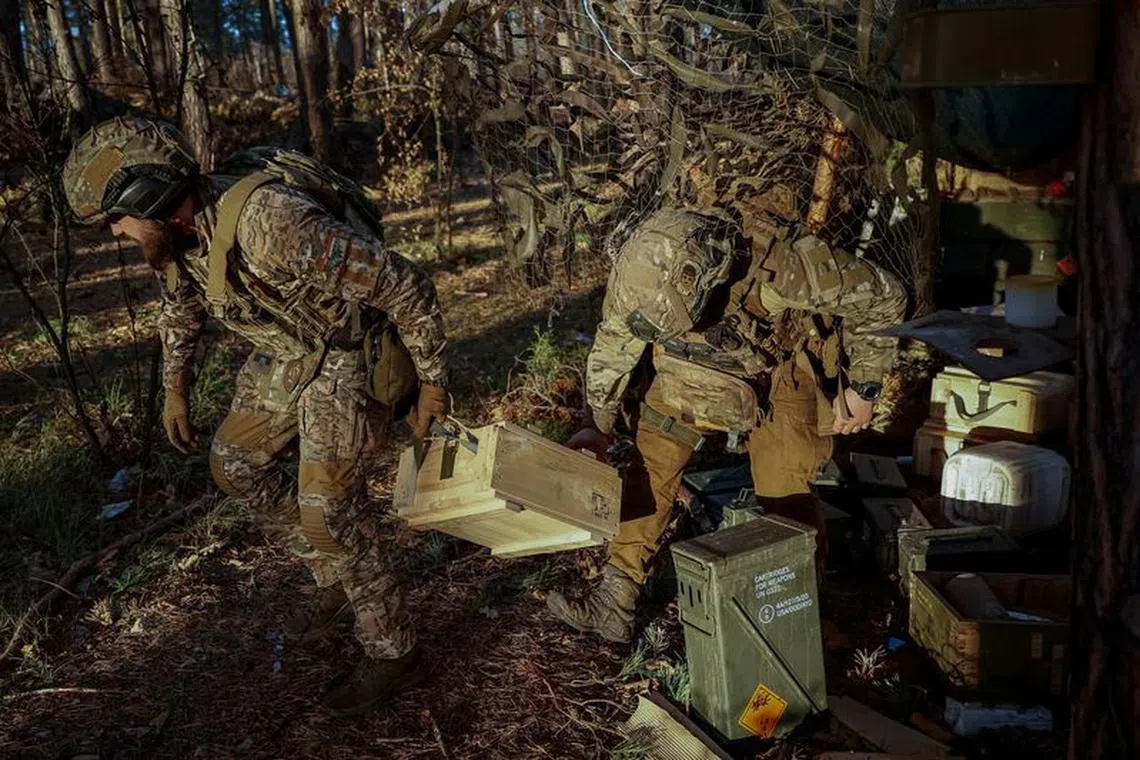How Ukraine's counter-offensive has struggled so far
Sign up now: Get ST's newsletters delivered to your inbox

Servicemen of the 67th Mechanised Brigade of the Armed Forces of Ukraine carry a box with an ammunition to a position in a frontline near Kreminna, amid Russia's attack on Ukraine, in Luhansk region, Ukraine November 2, 2023. REUTERS/Alina Smutko/File photo
Follow topic:
Here is a snapshot of the main battlefield developments in Ukraine since the start of Kyiv's latest counteroffensive in early June.
After Ukraine made spectacular territorial gains in the second half of 2022, hopes were high in Kyiv and among its allies for further significant successes this year along the frontline of up to 1,000 km (620 miles). Western weaponry including state-of-the-art tanks and long-range missiles had boosted such expectations.
But the gains so far have been small, as improved Russian defences proved effective, and any momentum created in the south and east looks to have run out of steam for now.
The weather is turning wet, making the ground boggy and difficult to navigate for heavy equipment, though freezing temperatures should eventually harden the earth and improve manoeuvrability as winter sets in.
On Oct. 31, Ukrainian President Volodymyr Zelenskiy said expectations of success were unrealistic, but that away from the front his forces had diminished Russia's military strength in the Black Sea in a potentially decisive development.
Ukraine's commander-in-chief, General Valery Zaluzhnyi, spoke of a "stalemate" in the war.
SOUTHERN FRONT NEAR KHERSON
For months after the huge Soviet-era Kakhovka dam was blown up in early June - a disaster which both warring parties blamed on each other - the frontline along the Dnipro River running southwest into the Black Sea barely budged.
But in mid-October, some Russian military bloggers reported that Ukrainian forces had formed a small bridgehead on the eastern bank. At the time, Russia said it had thwarted an attempt by Ukraine to cross the Dnipro. Kyiv has not provided details of any operation.
SOUTHERN FRONT
Battlefield maps using open-source information to track progress in fighting showed that in early June, Russia had reinforced its positions along the southern front with more troops.
Shortly after, Ukrainian soldiers breached the first line of defences south of the town of Velyka Novosilka in the first known breakthrough of the counteroffensive. Reuters reported from the liberated village of Neskuchne on June 13.
Over the following months, Ukraine made further incremental gains in the same area and also to the south of the town of Orikhiv, some 80 km (50 miles) further west.
Ukraine has reported tough resistance as it edges forward, including the threat of heavily mined land. The advances still leave it 80-90 km from the Sea of Azov, where military analysts say it aims to slice the Russian army in two and sever supply lines to the Crimea, the peninsula Russia annexed in 2014.
EASTERN FRONT NEAR AVDIIVKA
The devastated town of Avdiivka, close to the Russian-held Ukrainian city of Donetsk, has seen periods of fierce bombardment and fighting throughout the war.
The pre-war population of 30,000 people has dwindled to around 1,500 as civilians flee missile attacks, shelling and air raids, as well as ground battles that intensified in recent weeks.
Russian forces have begun to encircle the town, just as they did with the city of Bakhmut further north earlier in 2023, and while Ukraine has vowed to defend Avdiivka, supply lines in and out are coming under pressure.
EASTERN FRONT NEAR BAKHMUT
In late May, Russia's mercenary Wagner group claimed to have captured Bakhmut after some of the bloodiest fighting of the war. It was the only significant victory Moscow could claim since its forces left Kyiv's suburbs and then retreated around Kharkiv in the north and Kherson in the south in late 2022.
Thousands of troops on both sides died in attritional fighting that reduced Bakhmut to rubble. Its strategic importance has been questioned by some military analysts.
Despite that, Ukraine has committed significant resources to regaining territory around Bakhmut, and has reached the southern and western outskirts of the city.
EASTERN FRONT NEAR KUPIANSK
The remainder of the front, running north to the border with Russia's Belgorod region, has not moved significantly in months, although Kyiv has noted a major intensification in Russian attacks near the Ukraine-held city of Kupiansk this autumn.
BEHIND ENEMY LINES
Ukraine's Western allies have supplied it with longer range missiles capable of striking targets behind Russian lines inside Ukrainian territory. There have been several high-profile attacks, the details of which are often sketchy and disputed by the two sides.
While the strikes could upset Russian logistics and defence capabilities, it is difficult to gauge whether they will significantly change the course of the war.
On Sept. 13, Ukraine struck a dry dock in the Crimean city of Sevastopol, home to Russia's Black Sea fleet which Moscow uses to project power in the Middle East and Mediterranean and to blockade Ukrainian seaborne exports.
Military analysts and authorities in Kyiv said Ukraine had badly damaged a large landing ship and an attack submarine.
Just over a week later, a Ukrainian missile attack hit Russia's Black Sea naval headquarters in Sevastopol.
In mid-October, Ukrainian forces used U.S.-supplied long-range ATACMS missiles for the first time, damaging airfields near Luhansk in Ukraine's east and in Berdiansk on the Sea of Azov, both under Russian control. REUTERS

